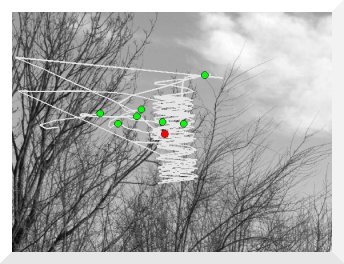
Ian
van der Linde, Umesh
Rajashekar, Alan
C. Bovik, and Lawrence
K. Cormack
Laboratory for Image
& Video Engineering (LIVE)
Center for Perceptual
Systems, The University of
Texas at Austin
Introduction
DOVES
(a Database Of Visual Eye movementS) is a collection of eye movements
from 29 human observers as they viewed 101 natural calibrated
images. Recorded using a high-precision dual-Purkinje eye tracker,
the database consists of around 30,000 fixation points, and is
believed to be the first large-scale database of eye movements
to be made available to the vision research community. The database,
along with MATLAB functions for its use, may be download freely
here, and may be used without restriction for educational and
research purposes, providing that our paper/this website are cited
in any published work.
|
We have decided to make the data set available
to the vision research community free of charge. If you
use this database in your research, we kindly ask that
you reference this website and the following article:
The still images used in this experiment were selected
from the Natural
Stimuli Collection created by Hans van Hateren. The
images used are modified from the original natural image
stimuli, by cropping and using only the central 1024x768
pixels. Permission to release the modified images on this
site was graciously granted by van Hateren. In addition
to the above citation, we ask that you acknowledge van
Hateren's image database in your publications, following
the instructions provided in http://hlab.phys.rug.nl/archive.html.
The zipped files have been password protected.
Please email Ian van der Linde (ianvdl@bcs.org)
for the password. Kindly indicate your university/industry
affiliation and a brief description of how you plan to
use the database. |
Using
the database
Download
entire database here.
If you download this database, it is assumed that you agree to
this copyright agreement.
Folders
in Database:
- Images:
This folder contains the 101 natural image stimuli used in
our experiments.
- Fixations:
This folder contains the eye movement data for each image,
stored as a separate .mat file. Both raw eye movements and
computed fixations are stored in each .mat file. Run view_doves_fix.m
to see an example of how to use this data.
- RawData:
This folder contains, in plain text format, all the information
that was collected in the course of the experiment. Each file
corresponds to an observer. Besides the raw eye movement data,
you can obtain information for the memory task, results of
eye movement calibration, and other details of the experiment,
including mining for eye movement statistics. Since the information
is stored in plain text format, it will be compatible with
any user-written software and does not require the use of
MATLAB. If you prefer to use your own algorithm to compute
fixations, you may use the raw eye movement data from the
Fixations folder or from this folder.
- Code:
This folder contains a selection of MATLAB programs that will
help you access the data in DOVES.
- view_doves_fix.m:
This program illustrates how to read in an image, the
corresponding eye movement data from the Fixations
folder. The eye movement data for each subject is then
superimposed on the image.
- view_doves_fixduration.m:
A program to illustrate extraction of fixation duration
- view_doves_raweye.m:
This program illustrates how to read in the raw eye movement
data stored in the RawData follder. This information
is also accessible from the data in the Fixations
folder.
- view_doves_rawcalib.m:
This program illustrates extraction of just the eye movement
calibration data from the RawData folder.
- view_task_results.m:
A program that reads in the results of the yes-no memory
task, and counts the number of hits, misses, correct rejections,
and false alarms.
Examples
from the database
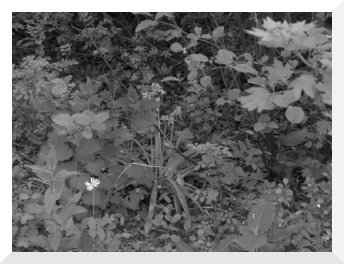
Original Image
|
 |

|
|
Fixations of first subject. Red square shows first fixation.
Green dots show computed fixations. White line shows the
"raw" eye movement trace. |
Fixations
of second subject. Note how both subjects fixate on the
flower as expected. |
- The user
can also analze the fixation duration for a subject or collect
fixations of all subjects for a single image
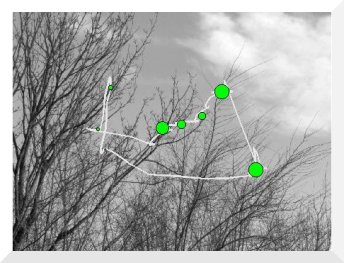 |
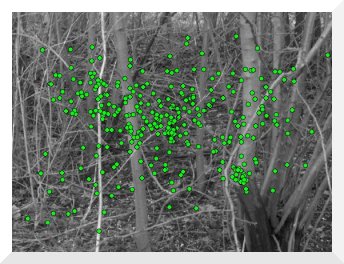
|
| An
example of fixation duration is indicated by the size of the
circles. |
An
example of fixations from all subjects on an image |
- Example
of the eye tracker "losing track": If you plan to
use your own code to generate fixations from the eye movement
data, please be aware that, the tracker may have occasionally
lost track of the observer's eyes. This can be seen in the eye
movement trace as a repeated vertical sinusoidal path. Your
fixation algorithm should be able to ignore this, since its
spatio-temporal dynamics do not resemble those of a human fixation.
As can be seen in the following figure, our fixation algorithm
does not compute fixations in the sinusoidal data, but captures
fixations otherwise.
|
An
example of the eye tracker losing ability to track |
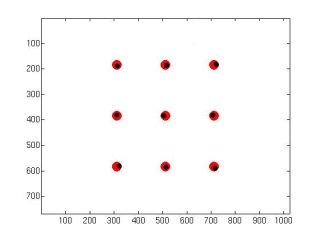
|
An example of the eye tracker calibration. The red dots
show the location of calibration locations. Black dots are
the subject's recorded eye positions when looking at the
red dots. |
-----------COPYRIGHT
NOTICE STARTS WITH THIS LINE------------
Copyright © 2007 The University of Texas at Austin
All rights reserved.
Permission
is hereby granted, without written agreement and without
license or royalty fees, to use, copy, modify, and distribute
this database (the eye movement data only) and its documentation
for any purpose, provided that the copyright notice in
its entirety appear in all copies of this database, and
the original source of this database, Laboratory for Image
and Video Engineering (LIVE, http://live.ece.utexas.edu)
and Center for Perceptual Systems (CPS, http://www.cps.utexas.edu)
at the University of Texas at Austin (UT Austin, http://www.utexas.edu),
is acknowledged in any publication that reports research
using this database. The database is to be cited in the
bibliography as:
The still images used in this experiment were selected
from the
Natural Stimuli Collection created by Hans van Hateren.
The images used are modified from the original natural
image stimuli, by cropping and using only the central
1024x768 pixels. Permission to release the modified images
on this site was graciously granted by van Hateren. In
addition to the above citation, we ask that you acknowledge
van Hateren's image database in your publications, following
the instructions provided in http://hlab.phys.rug.nl/archive.html.
IN
NO EVENT SHALL THE UNIVERSITY OF TEXAS AT AUSTIN BE LIABLE
TO ANY PARTY FOR DIRECT, INDIRECT, SPECIAL, INCIDENTAL,
OR CONSEQUENTIAL DAMAGES ARISING OUT OF THE USE OF THIS
DATABASE AND ITS DOCUMENTATION, EVEN IF THE UNIVERSITY
OF TEXAS AT AUSTIN HAS BEEN ADVISED OF THE POSSIBILITY
OF SUCH DAMAGE.
THE
UNIVERSITY OF TEXAS AT AUSTIN SPECIFICALLY DISCLAIMS ANY
WARRANTIES, INCLUDING, BUT NOT LIMITED TO, THE IMPLIED
WARRANTIES OF MERCHANTABILITY AND FITNESS FOR A PARTICULAR
PURPOSE. THE DATABASE PROVIDED HEREUNDER IS ON AN "AS
IS" BASIS, AND THE UNIVERSITY OF TEXAS AT AUSTIN
HAS NO OBLIGATION TO PROVIDE MAINTENANCE, SUPPORT, UPDATES,
ENHANCEMENTS, OR MODIFICATIONS.
-----------COPYRIGHT
NOTICE ENDS WITH THIS LINE------------
|
|






